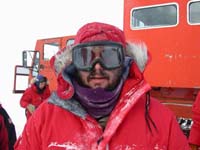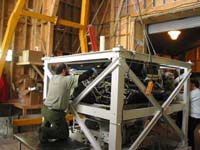Imagine the Universe News - 30 Nov 2001
A TIGER in Antarctica
| 30 Nov 2001 |
 |
| Eric Christian, dressed for the cold in Antarctica |
High above the chilly continent of Antarctica, far beyond the sight of even the sharpest-eyed penguins, scientists are flying a massive balloon with an instrument that catches tiny bits of matter that have traveled across much of the Milky Way galaxy, perhaps strewn by ancient star explosions.
These well-journeyed particles are called cosmic rays, essentially atomic nuclei (atoms stripped of electrons) that fly at near light speed. Such particles bombard the Earth constantly, yet scientists do not know for sure where they originate.
Eric Christian, who works for Universities Space Research Association at NASA Goddard Space Flight Center, is braving the cold to solve the mystery of cosmic rays. Dr. Christian is a co-investigator on the TIGER experiment, short for Trans-Iron Galactic Element Recorder. The principal investigator heading the team is Dr. Bob Binns of Washington University in St. Louis. TIGER will ride on a balloon more than 35 kilometers above Antarctica and fly around the South Pole twice, a 20- to 30-day tour.
Cosmic rays are like storytellers, bringing us tales of the origin and distribution of matter in the Universe. The types of cosmic rays that TIGER will collect provide clues to where the cosmic rays in general come from and what sent them flying to near light speed.
Why Antarctica? It's not as if Dr. Christian isn't thrilled to be there. In fact, he has brought with him his trusty "webcam" and, for several weeks in December, he is interacting "live" with school children in New York and New Jersey. You too, in fact, can follow his adventures on the TIGER web site.
Right, but why Antarctica? Flying a balloon from Antarctica offers two advantages. The first is long, continuous balloon flights. In December and January, the Antarctica "summer," the Sun never sets. This means the temperature stays relatively constant high up in the atmosphere 24 hours a day. Daytime/nighttime temperature fluctuations cause balloons to slowly lose altitude, often in as little as a few days. But constant daylight in Antarctica means balloons can stay aloft for three weeks and more. In addition, the constant daylight means the instrument can be powered just by the solar arrays, and heavy batteries need not be part of the payload. Best of all, the longer the flight, the more cosmic rays TIGER can collect.
Antarctica is also a good spot to catch cosmic rays because the Earth's magnetic field, which shields us from most of these atomic particles, dips down and is closest to the Earth's surface at the North and South Pole. So more cosmic rays penetrate the Earth's atmosphere above the Arctic and Antarctic than anywhere else in the world.
TIGER will lift off from McMurdo Station. The instrument, which will be suspended below a balloon larger than the size of an American football field, will measure the elemental composition of cosmic rays between zinc and molybdenum in the periodic table. TIGER is particularly hungry for rubidium-37, and germanium.
 |
| The TIGER instrument being prepared for its flight. |
Scientists think that cosmic rays come from star explosions. But do they race out like shrapnel? Or are particles expelled and sit around for awhile before the shock wave of other star explosions accelerates them to higher speeds.
TIGER, in its hunt for rubidium-37 and other elements, formally address the questions: "What is the source of the material that is accelerated to cosmic ray energies?" and "What is the mechanism for injecting that material into the cosmic-ray accelerator?"
If the source material for cosmic rays is hot gas (that is, newly exploded stars), then TIGER will see more cosmic rays that are low First Ionization Potential (FIP) nuclei. FIP refers to sheer heat ionizing an atomic nucleus, stripping it of electrons. But, if the potential cosmic ray material sat "cold" for awhile and latched onto interstellar dust grains, waiting for some wind to accelerate them to high speeds later, then TIGER will see more "low-volatility" nuclei.
The idea in this second scenario is that those elements that do not evaporate easily will cling to interstellar dust. These 10-micron dust grains are already moving at a nice click when they pick up their hitchhikers. Then a supernova blast comes and kicks them to cosmic-ray speeds. The dust grains break apart from interactions with ultraviolet or x-ray photons, but the atomic particles that hitched the ride are now moving fast enough (and thus have enough energy) to become cosmic rays.
Here's where rubidium-37 is important. Rb-37 evaporates easily. The element won't remain in a solid form and cling to a dust grain. It evaporates off of the dust grain and thus never has a chance to hitch a ride.
If TIGER collects a lot of Rb-37, this means the FIP mechanism is taking place. The Rb-37 can only reach cosmic energies if it came blasting out of a star explosion. The dust-hitchhiking scenario won't work for Rb-37. If TIGER collects few Rb-37 particles but instead many low-volatility particles, then this points to the dust theory.
TIGER is a forerunner of the ENTICE (ENergetic Trans-Iron Composition Experiment) instrument on HNX (the Heavy Nuclei Explorer). HNX is a satellite that may launch in 5 years, and what TIGER learns will help in the design of HNX.
Dr. Christian is knowledgeable not only about cosmic rays but also about the physics, geography and the history of science in Antarctica. He has even taken "survival training," which means he's permitted to explore Antarctica. He welcomes your questions about Antarctica by email through December while he is at McMurdo Station.

